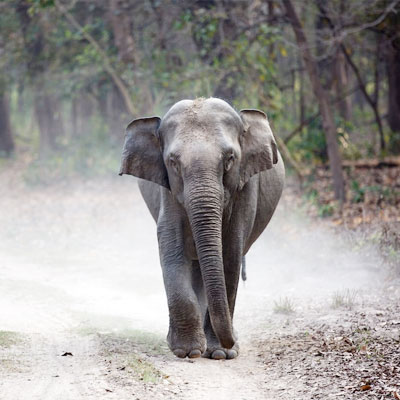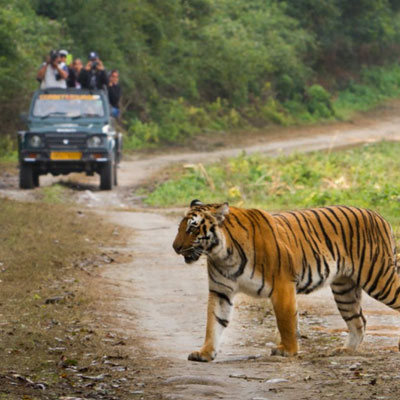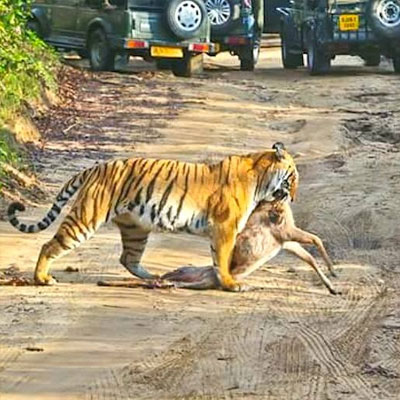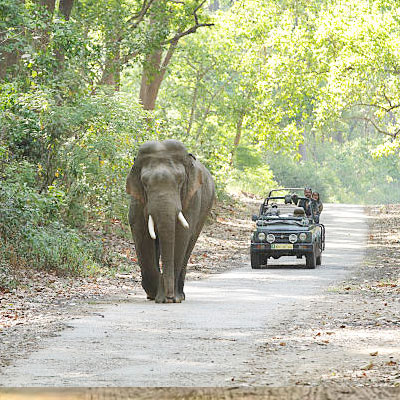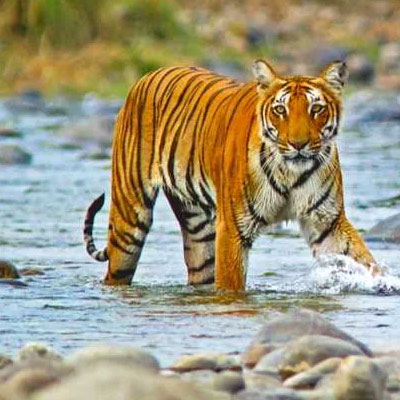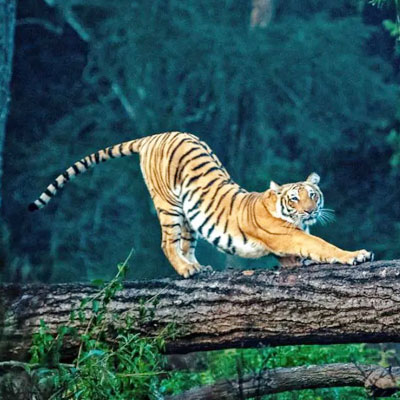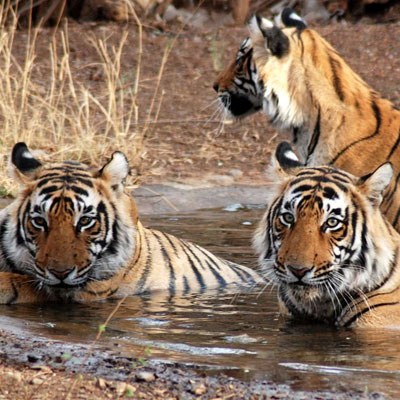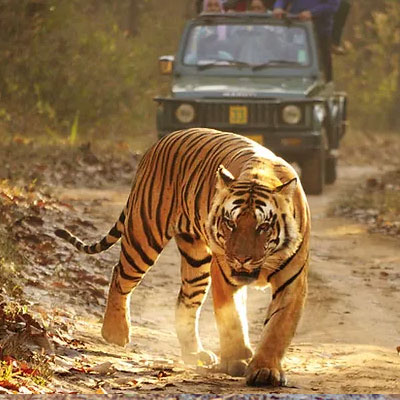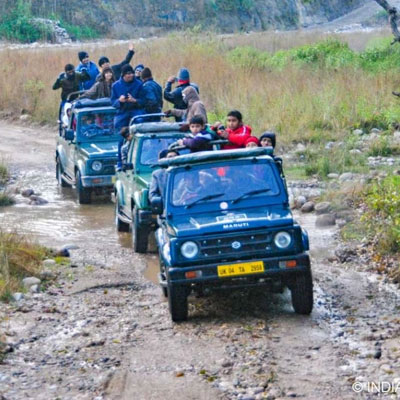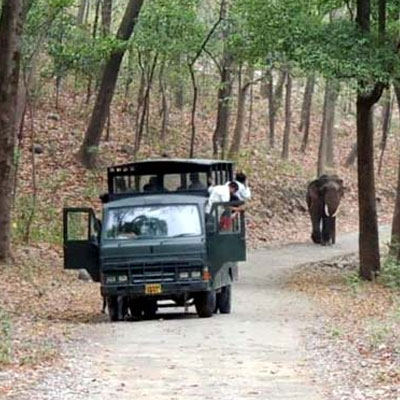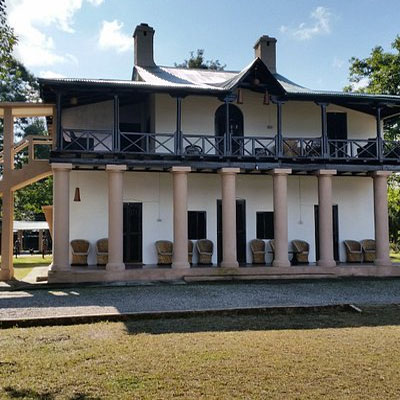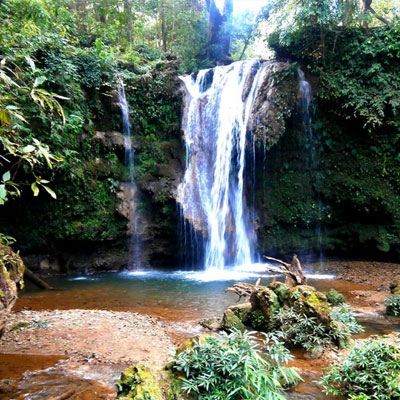
Dhikala Forest Lodge Jim Corbett:-
Dhikala Forest Lodge is a popular accommodation option located within the Jim Corbett National Park in Uttarakhand, India. Jim Corbett National Park is one of India’s oldest and most famous national parks, known for its diverse wildlife and natural beauty. Dhikala Forest Lodge is situated in the heart of the park, offering visitors a unique opportunity to immerse themselves in the wilderness.
Here are some key points about Dhikala Forest Lodge:
Location: Dhikala Forest Lodge is located in the core area of Jim Corbett National Park, which is renowned for its rich biodiversity and is home to a variety of wildlife, including tigers, elephants, leopards, deer, and numerous bird species.
Accommodation: The lodge offers basic but comfortable accommodation options, including dormitories and cottages. These accommodations are designed to blend in with the natural surroundings and provide a rustic, yet comfortable, experience for visitors.
Activities: Staying at Dhikala Forest Lodge provides guests with the opportunity to go on jungle safaris and wildlife excursions. Jeep safaris and elephant safaris are popular ways to explore the park and spot wildlife in their natural habitat. Birdwatching is also a favorite activity among nature enthusiasts.
Wildlife Viewing: Jim Corbett National Park is famous for its tiger population, and Dhikala is one of the best places in the park to spot these majestic big cats. In addition to tigers, you can also see other animals like leopards, sloth bears, crocodiles, and a wide variety of bird species.
Booking: Due to its popularity, booking a stay at Dhikala Forest Lodge can be challenging, and it’s recommended to make reservations well in advance. Bookings can typically be made through the official website of the Jim Corbett National Park or through authorized agents.
Seasons: The best time to visit Dhikala Forest Lodge and Jim Corbett National Park is from November to June when the park is open to tourists. The park remains closed during the monsoon season (July to September) due to heavy rainfall.
Rules and Regulations: Visitors are required to follow strict rules and regulations while staying at Dhikala Forest Lodge to ensure the safety of both guests and wildlife. These rules include maintaining silence, not carrying any firearms, and respecting the natural environment.
Dhikala Forest Lodge offers a unique and immersive wildlife experience for nature enthusiasts and wildlife lovers, allowing them to get up close and personal with the diverse flora and fauna of Jim Corbett National Park.
Forest Rest House in Jim Corbett:-
Jim Corbett National Park in Uttarakhand, India, offers several forest rest houses for visitors who want to experience the park’s natural beauty and wildlife. These forest rest houses are operated by the forest department and provide basic accommodation facilities within the park. Here are some notable forest rest houses in Jim Corbett National Park:
Dhikala Forest Rest House: Dhikala is one of the most popular forest rest houses in Jim Corbett. It is located in the core area of the park, overlooking the Ramganga River. Dhikala offers a range of accommodations, including old forest rest houses, new forest rest houses, and log huts. It provides an excellent chance to observe wildlife, including tigers, elephants, and various bird species.
Gairal Forest Rest House: Gairal is another well-known rest house in the park and is located along the banks of the Ramganga River. It offers comfortable accommodations and is known for its lush green surroundings.
Sarapduli Forest Rest House: Sarapduli is a forest rest house located on the banks of the Mandal River. It offers a serene environment and is an excellent spot for birdwatching.
Sultan Forest Rest House: Sultan is located near the Sultan Wildlife Sanctuary in the park and provides a unique opportunity to explore this part of the park.
Malani Forest Rest House: Malani is located in the Sonanadi Wildlife Sanctuary, which is a peaceful and less crowded area of the park. It’s a great place for nature lovers and those looking for a quieter experience.
Jhirna Forest Rest House: Jhirna is located in the southern part of the park and is known for its diverse flora and fauna. It’s a popular destination for wildlife enthusiasts.
Lohachaur Forest Rest House: Lohachaur is situated on the banks of the Mandal River and offers a tranquil environment for guests.
It’s important to note that these forest rest houses are operated by the forest department, and accommodation availability can be limited. Therefore, it’s advisable to make reservations well in advance through the official website of Jim Corbett National Park or authorized agents. Visitors must also follow park rules and regulations to ensure the safety of both guests and wildlife during their stay.
Exploring Dhikala Zone in Jim Corbett:-
Exploring the Dhikala Zone in Jim Corbett National Park is a thrilling experience for wildlife enthusiasts and nature lovers. The Dhikala Zone is one of the most popular and picturesque areas of the park, known for its rich biodiversity and excellent opportunities for wildlife sightings. Here are some ways to explore and enjoy the Dhikala Zone:
Jungle Safaris: The most common way to explore Dhikala is by taking a jungle safari. You can opt for a Jeep safari or an elephant safari, both of which offer unique experiences. Jeep safaris are ideal for getting deeper into the forest and cover more ground, while elephant safaris provide a quieter and closer wildlife viewing experience. These safaris are typically conducted in the early morning or late afternoon when wildlife is more active.
Birdwatching: Dhikala is a birdwatcher’s paradise, with a diverse range of avian species. Bring your binoculars and camera to spot and capture the beauty of various birds, including hornbills, eagles, and kingfishers.
River Safari: The Ramganga River flows through the Dhikala Zone, and you can take a river safari to explore its banks. It’s an excellent opportunity to spot crocodiles, gharials, and other aquatic life. The river safari also provides a different perspective of the park’s landscape.
Guided Nature Walks: Many lodges and guides offer guided nature walks within the Dhikala Zone. These walks allow you to explore the smaller wonders of the forest, including insects, plants, and smaller wildlife. It’s a great way to connect with nature on a more intimate level.
Visit the Dhikala Watchtower: The Dhikala Watchtower provides panoramic views of the grasslands and river, making it an excellent spot for wildlife sightings and photography. It’s also a serene place to enjoy the sunrise or sunset.
Photography: Whether you’re a professional photographer or just enjoy taking pictures, the Dhikala Zone offers incredible opportunities for wildlife and landscape photography. Make sure to carry appropriate camera equipment and respect wildlife viewing ethics.
Relax and Enjoy Nature: Dhikala is not just about wildlife sightings; it’s also about immersing yourself in the natural beauty of the park. Take time to relax, listen to the sounds of the forest, and appreciate the serene surroundings.
Remember that visiting the Dhikala Zone requires obtaining permits and following park regulations. It’s advisable to book your safari and accommodations well in advance, especially during the peak tourist season. Additionally, respect the park’s rules and maintain a responsible and eco-friendly approach to wildlife viewing and nature exploration.
Dhikala Jungle Safari Adventures - Jeep & Canter:-
Dhikala Jungle Safari Adventures in Jim Corbett National Park offer exciting opportunities to explore the park’s wilderness and observe its diverse wildlife. Two popular safari options for exploring Dhikala are Jeep Safaris and Canter Safaris. Here’s a closer look at these safari adventures:
Jeep Safaris:
- Vehicle: In a Jeep Safari, you will typically ride in a 4×4 open-roof jeep or a smaller vehicle that can navigate through the park’s rugged terrain. These vehicles provide a more intimate and flexible safari experience.
- Group Size: Jeep safaris are usually limited to a smaller group of tourists, allowing for a more personalized and focused wildlife viewing experience.
- Flexibility: Jeeps can venture deeper into the forest, increasing your chances of encountering elusive animals like tigers and leopards. Guides can also tailor the safari route based on specific wildlife sightings and interests.
- Timings: Jeep safaris are conducted during the early morning and late afternoon when wildlife is most active.
Canter Safaris:
- Vehicle: Canter Safaris use larger vehicles with open sides, resembling a modified safari bus. These vehicles can accommodate a larger number of tourists, making it a more budget-friendly option.
- Group Size: Canter safaris typically have a larger group size compared to jeep safaris, which can sometimes result in a less personalized experience.
- Route: Canter safaris follow predefined routes within the park. While this means less flexibility in choosing your route, it can be suitable for tourists looking for a more structured experience.
- Timings: Canter safaris also operate during the early morning and late afternoon for optimal wildlife sightings.
Both Jeep and Canter safaris offer their own unique advantages and experiences. When choosing between them, consider your preferences, budget, and the kind of wildlife experience you’re seeking.
Tips for Enjoying Dhikala Jungle Safaris:
- Book your safari well in advance, especially during the peak tourist season, to secure your spot.
- Arrive at the safari departure point on time to ensure you don’t miss your safari.
- Wear appropriate clothing for safaris, including comfortable and muted-colored clothing. Avoid bright colors.
- Bring binoculars and a camera with a telephoto lens to capture wildlife sightings.
- Listen to your safari guide’s instructions and follow park rules, including maintaining silence and not disturbing the animals.
- Be patient and keep your eyes peeled for wildlife. Remember that wildlife sightings are not guaranteed, and luck plays a role.
Exploring the Dhikala Zone through Jeep and Canter safaris is an incredible way to immerse yourself in the natural beauty and wildlife of Jim Corbett National Park, creating memorable adventures and opportunities to witness India’s iconic wildlife.
Accommodations and Stays in Dhikala:-
Dhikala is a popular area within Jim Corbett National Park in Uttarakhand, India, known for its rich biodiversity and wildlife. It offers a few accommodation options for visitors who want to stay in the heart of the park and experience its natural beauty. Here are some of the accommodations and stays in Dhikala:
Dhikala Forest Lodge: Dhikala Forest Lodge is the primary accommodation option in Dhikala and is run by the forest department. It provides basic yet comfortable lodging options, including old forest rest houses, new forest rest houses, and log huts. These accommodations are designed to blend in with the natural surroundings and offer a rustic experience. Due to its popularity, booking well in advance is essential.
Safari Tents: In addition to the Forest Lodge, there are safari tents available in Dhikala. These tents offer a unique camping experience within the park’s boundaries. They are equipped with basic amenities and provide an opportunity to connect with nature closely.
Forest Rest Houses: Apart from Dhikala, there are several forest rest houses in other zones of Jim Corbett National Park, including Gairal, Sultan, Malani, and Jhirna. These rest houses are situated in different areas of the park, offering a variety of experiences. Booking forest rest houses is managed by the forest department and requires advance planning.
River View Guesthouses: Some guesthouses in Dhikala and nearby areas offer comfortable accommodations with river views. These are often privately owned or operated by the forest department. They provide a serene environment and a chance to relax while enjoying the scenic beauty of the Ramganga River.
Eco Lodges and Resorts: There are a few eco-friendly lodges and resorts located just outside the park boundaries that offer comfortable stays with modern amenities. While not inside the park, these accommodations provide a convenient base for exploring the Dhikala Zone during the day.
Camping: Some tour operators offer camping experiences near Dhikala. Camping allows you to experience the wilderness more intimately. It’s essential to ensure that camping activities are conducted responsibly and in compliance with park regulations.
When planning a stay in Dhikala, it’s crucial to consider factors such as booking permits, availability, and the season of your visit. Dhikala and other forest rest houses are in high demand, so making reservations well in advance is advisable
Birdwatching Paradise: Dhikala Zone:-
Dhikala Zone in Jim Corbett National Park is indeed a birdwatcher’s paradise. This region is renowned for its rich avian diversity and offers bird enthusiasts a fantastic opportunity to observe a wide variety of bird species. Here’s why Dhikala Zone is considered a birdwatching paradise:
Diverse Habitats: Dhikala encompasses various habitats, including riverbanks, grasslands, dense forests, and wetlands. These diverse ecosystems attract a broad range of bird species, making it an ideal location for birdwatching.
Ramganga River: The Ramganga River flows through Dhikala, creating an excellent habitat for both waterfowl and terrestrial birds. You can often spot kingfishers, herons, egrets, and other water-loving birds along the riverbanks.
Open Grasslands: The vast grasslands of Dhikala are home to numerous bird species, including the Indian roller, crested serpent eagle, vultures, and various larks and pipits. The open landscape provides excellent visibility for birdwatchers.
Wooded Areas: The dense Sal forests in Dhikala are home to many woodland bird species. Look out for barbets, woodpeckers, owls, and various warblers while exploring the forested sections of the zone.
Raptors: Dhikala is known for its population of raptors. Keep an eye out for birds of prey such as crested hawk-eagles, changeable hawk-eagles, serpent eagles, and the critically endangered white-rumped vulture.
Endemic and Rare Species: The park is home to several rare and elusive bird species, including the great hornbill, pallas’s fish eagle, tawny fish owl, and the endangered white-winged wood duck. Birdwatchers often consider themselves fortunate when they spot these elusive species.
Professional Guides: To enhance your birdwatching experience, consider hiring a professional guide who is knowledgeable about the local avian fauna. Guides can help you identify birds by sight and sound, increasing your chances of spotting specific species.
Photography Opportunities: Dhikala’s picturesque landscapes and diverse birdlife provide excellent opportunities for bird photography. Be sure to bring your camera and telephoto lens to capture these avian wonders.
Safeguarding Biodiversity in Dhikala:-
Safeguarding biodiversity in Dhikala, as well as in Jim Corbett National Park as a whole, is of paramount importance to ensure the long-term survival of its unique and diverse ecosystems. Here are some key strategies and initiatives for protecting biodiversity in Dhikala:
Habitat Protection:
- Preserve and protect diverse habitats within Dhikala, including grasslands, riverbanks, wetlands, and forests, which support various wildlife species.
Strict Regulation and Monitoring:
- Enforce strict regulations on activities within the park, including restrictions on hunting, logging, and other harmful practices.
- Implement and regularly monitor anti-poaching measures to deter illegal wildlife activities, such as poaching and the illegal wildlife trade.
Conservation Initiatives:
- Establish conservation programs and projects aimed at protecting threatened species, such as tigers, elephants, and vultures.
- Implement captive breeding and reintroduction programs for endangered species to boost their populations.
Community Involvement:
- Involve local communities in conservation efforts by providing education and alternative livelihoods that reduce their dependence on the park’s resources.
- Encourage local residents to participate in eco-tourism initiatives, creating a sense of ownership and responsibility for the park’s biodiversity.
Awareness and Education:
- Raise awareness about the importance of biodiversity conservation among visitors, local communities, and park staff.
- Conduct educational programs and workshops to foster a deeper understanding of the park’s ecosystems and wildlife.
Research and Monitoring:
- Support ongoing research projects to better understand the park’s biodiversity, monitor population trends, and assess the impact of human activities on wildlife.
- Utilize technology like camera traps, GPS tracking, and satellite imagery for effective monitoring and data collection.
Sustainable Tourism Practices:
- Regulate and manage tourism activities to minimize their impact on the environment and wildlife. Limit the number of vehicles and tourists allowed in sensitive areas.
- Promote responsible tourism practices, including adhering to wildlife viewing ethics and maintaining silence during safaris.
Fire Management:
- Implement controlled fire management strategies to prevent uncontrolled wildfires, which can be detrimental to the park’s ecosystems.
Invasive Species Control:
- Implement measures to control and manage invasive plant and animal species that can threaten native biodiversity.
Collaboration and Partnerships:
- Collaborate with governmental agencies, non-governmental organizations, and international partners to pool resources, expertise, and funding for biodiversity conservation efforts.
Long-term Planning:
- Develop and implement long-term conservation and management plans that prioritize biodiversity preservation and sustainable resource use.
Safeguarding biodiversity in Dhikala requires a multi-faceted approach that combines regulatory measures, community involvement, scientific research, and responsible tourism practices. The aim is to strike a balance between conserving the park’s natural heritage and allowing sustainable human activities within its boundaries.
Dhikala's Natural Beauty and Landscapes:-
Dhikala in Jim Corbett National Park is renowned for its breathtaking natural beauty and diverse landscapes. This region offers a wide array of picturesque settings and landscapes that are a treat for nature enthusiasts and photographers. Here are some aspects of Dhikala’s natural beauty and landscapes:
River Ramganga: The Ramganga River flows gracefully through the heart of Dhikala. Its serene waters, especially during the dawn and dusk, provide a reflective surface that enhances the beauty of the landscape. The riverbanks are often visited by various wildlife species, making it an ideal spot for wildlife and bird photography.
Grasslands: Dhikala boasts vast grasslands, locally known as “chaurs.” These open expanses are not only aesthetically pleasing but also serve as vital grazing grounds for herbivores like deer and elephants. The grasslands provide excellent opportunities for spotting wildlife, including tigers and leopards.
Sal Forests: The dense Sal forests of Dhikala create a rich green canopy that extends as far as the eye can see. These forests are not only visually stunning but also home to an incredible variety of flora and fauna. Walking or driving through the Sal forests is an immersive experience in itself.
Sunrise and Sunset Views: The open vistas of Dhikala are perfect for enjoying spectacular sunrises and sunsets. Watching the sun paint the sky with hues of orange and pink over the Ramganga River or the grasslands is a memorable experience.
Himalayan Foothills: Dhikala is located at the foothills of the Himalayas, offering stunning views of the surrounding hills and mountains. On clear days, you can catch glimpses of the snow-capped peaks in the distance.
Wildlife Corridors: The park’s diverse landscapes include crucial wildlife corridors that facilitate the movement of animals between different parts of the park. These corridors are often bordered by lush vegetation and provide opportunities to spot wildlife on the move.
Diverse Flora: Dhikala is home to a wide variety of plant species, including tall Sal trees, bamboo groves, and flowering plants. The changing seasons bring distinct colors and moods to the landscape, making it a year-round destination.
Wetlands and Marshes: In addition to the river, Dhikala has several wetlands and marshes. These areas are essential for waterfowl and other bird species. Birdwatchers can enjoy observing a multitude of water-loving birds in these serene wetland habitats.
Scenic Watchtowers: Dhikala has strategically placed watchtowers that provide panoramic views of the landscapes and wildlife. The Dhikala Watchtower, in particular, offers fantastic views of the surrounding areas.
Stars and Night Sky: The park’s remote location away from city lights makes it an excellent place for stargazing. On clear nights, you can witness a breathtaking canopy of stars and constellations.
Dhikala’s natural beauty and landscapes make it a paradise for nature lovers, photographers, and anyone seeking a peaceful retreat in the midst of the wild. Whether you’re exploring the grasslands, wandering through the Sal forests, or simply gazing at the river, Dhikala offers a visual and sensory feast of natural wonders.
Dhikala's Natural Beauty and Landscapes:-
Dhikala in Jim Corbett National Park is renowned for its breathtaking natural beauty and diverse landscapes. This region offers a wide array of picturesque settings and landscapes that are a treat for nature enthusiasts and photographers. Here are some aspects of Dhikala’s natural beauty and landscapes:
River Ramganga: The Ramganga River flows gracefully through the heart of Dhikala. Its serene waters, especially during the dawn and dusk, provide a reflective surface that enhances the beauty of the landscape. The riverbanks are often visited by various wildlife species, making it an ideal spot for wildlife and bird photography.
Grasslands: Dhikala boasts vast grasslands, locally known as “chaurs.” These open expanses are not only aesthetically pleasing but also serve as vital grazing grounds for herbivores like deer and elephants. The grasslands provide excellent opportunities for spotting wildlife, including tigers and leopards.
Sal Forests: The dense Sal forests of Dhikala create a rich green canopy that extends as far as the eye can see. These forests are not only visually stunning but also home to an incredible variety of flora and fauna. Walking or driving through the Sal forests is an immersive experience in itself.
Sunrise and Sunset Views: The open vistas of Dhikala are perfect for enjoying spectacular sunrises and sunsets. Watching the sun paint the sky with hues of orange and pink over the Ramganga River or the grasslands is a memorable experience.
Himalayan Foothills: Dhikala is located at the foothills of the Himalayas, offering stunning views of the surrounding hills and mountains. On clear days, you can catch glimpses of the snow-capped peaks in the distance.
Wildlife Corridors: The park’s diverse landscapes include crucial wildlife corridors that facilitate the movement of animals between different parts of the park. These corridors are often bordered by lush vegetation and provide opportunities to spot wildlife on the move.
Diverse Flora: Dhikala is home to a wide variety of plant species, including tall Sal trees, bamboo groves, and flowering plants. The changing seasons bring distinct colors and moods to the landscape, making it a year-round destination.
Wetlands and Marshes: In addition to the river, Dhikala has several wetlands and marshes. These areas are essential for waterfowl and other bird species. Birdwatchers can enjoy observing a multitude of water-loving birds in these serene wetland habitats.
Scenic Watchtowers: Dhikala has strategically placed watchtowers that provide panoramic views of the landscapes and wildlife. The Dhikala Watchtower, in particular, offers fantastic views of the surrounding areas.
Stars and Night Sky: The park’s remote location away from city lights makes it an excellent place for stargazing. On clear nights, you can witness a breathtaking canopy of stars and constellations.
Dhikala’s natural beauty and landscapes make it a paradise for nature lovers, photographers, and anyone seeking a peaceful retreat in the midst of the wild. Whether you’re exploring the grasslands, wandering through the Sal forests, or simply gazing at the river, Dhikala offers a visual and sensory feast of natural wonders.
Conservation Efforts in Dhikala Zone:-
Conservation efforts in Dhikala Zone, located within Jim Corbett National Park in India, are crucial for the protection and preservation of the region’s rich biodiversity. The Dhikala Zone is known for its diverse flora and fauna, including iconic species such as tigers, elephants, and various endangered species. Here are some of the key conservation efforts and initiatives in Dhikala Zone:
Habitat Protection and Restoration:
- Ensuring the protection and preservation of diverse habitats, including grasslands, riverbanks, wetlands, and forests, is essential. Efforts are made to maintain and restore these ecosystems to support a wide range of wildlife species.
Anti-Poaching Measures:
- Rigorous anti-poaching efforts are in place to combat illegal activities such as poaching and the illegal wildlife trade. This includes the deployment of forest guards, the use of patrolling teams, and the use of technology like camera traps for monitoring.
Research and Monitoring:
- Ongoing research projects help gather data on the park’s biodiversity, including population trends, behavior, and habitat use of various species. This information is vital for informed conservation decisions.
Community Involvement:
- Engaging with local communities living in the buffer zones of the park is critical. Conservationists work to raise awareness about the importance of wildlife conservation and provide alternative livelihoods to reduce dependence on forest resources.
Tiger Conservation:
- Dhikala Zone is home to a significant population of Bengal tigers. Specific efforts are made to monitor and protect these big cats, including tracking their movements and addressing human-wildlife conflicts.
Bird Conservation:
- The park’s rich avian diversity is also a focus of conservation. Efforts include the protection of nesting sites, wetland preservation, and monitoring of bird populations.
Elephant Conservation:
- Elephants are an integral part of Dhikala’s biodiversity. Conservationists work to protect and study the park’s elephant population, addressing human-elephant conflicts and ensuring their habitat remains intact.
Education and Awareness:
- Educational programs and workshops are conducted to raise awareness among park visitors, local communities, and park staff about the importance of conservation and responsible tourism.
Sustainable Tourism Practices:
- Sustainable tourism practices are implemented to minimize the impact of tourism on the environment and wildlife. This includes responsible safari management and visitor guidelines.
Collaboration and Partnerships:
- Collaborative efforts between governmental agencies, non-governmental organizations, and international partners help pool resources, expertise, and funding for effective conservation projects.
Fire Management:
- Controlled fire management strategies are employed to prevent uncontrolled wildfires, which can be detrimental to the park’s ecosystems.
Captive Breeding and Reintroduction:
- In some cases, captive breeding and reintroduction programs are implemented for endangered species to boost their populations.
Long-term Conservation Plans:
- Developing and implementing long-term conservation and management plans are essential to prioritize biodiversity preservation and sustainable resource use within Dhikala Zone.
These conservation efforts in Dhikala Zone aim to strike a balance between conserving the park’s natural heritage and allowing sustainable human activities within its boundaries. By addressing various conservation challenges and engaging local communities, these initiatives work towards ensuring the long-term survival of the region’s unique biodiversity.
Dhikala Travel Tips and Information:-
Traveling to Dhikala Zone within Jim Corbett National Park can be an incredible experience for nature and wildlife enthusiasts. To make the most of your trip and ensure a smooth visit, here are some important travel tips and information:
Entry Permits and Bookings:
- You need to obtain permits to enter the Dhikala Zone. These permits can be obtained through the official website of Jim Corbett National Park or from authorized agents.
- It is advisable to book your permits and accommodations well in advance, especially during peak tourist seasons.
Best Time to Visit:
- The best time to visit Dhikala is from November to June when the park is open to tourists. The park remains closed during the monsoon season (July to September) due to heavy rainfall.
Climate and Clothing:
- Dhikala experiences a range of temperatures throughout the year. Carry clothing suitable for both warm days and cooler nights.
- During safaris, wear muted and earthy colors to blend in with the surroundings. Avoid bright and flashy clothing.
Transportation:
- Dhikala Zone is accessible by road. The nearest major transportation hub is Ramnagar, which is well-connected to major cities in Uttarakhand and nearby states.
- Once in Ramnagar, you can hire a private taxi or use park-operated buses to reach Dhikala.
Accommodation:
- Dhikala offers various types of accommodations, including forest rest houses, safari tents, and eco-lodges. Choose your accommodation based on your preferences and budget.
- Facilities at forest rest houses are basic, so be prepared for a rustic experience.
Safari Options:
- Jeep safaris and Canter safaris are popular ways to explore Dhikala. Jeep safaris provide a more intimate experience, while Canters are larger vehicles suitable for larger groups.
- Safaris are conducted in the early morning and late afternoon, which are the best times for wildlife sightings.
Guide and Naturalist:
- It is recommended to hire a knowledgeable guide or naturalist who can enhance your safari experience by providing insights into the park’s wildlife and ecosystems.
Wildlife Viewing:
- Practice responsible wildlife viewing. Maintain silence during safaris and respect the animals’ space.
- Do not attempt to feed or approach the wildlife, and avoid making loud noises.
Photography:
- Dhikala is a paradise for photographers. Carry your camera and equipment, including telephoto lenses for wildlife photography.
Safety Precautions:
- Follow safety instructions provided by your guide and the park authorities.
- Be cautious of wildlife, especially while walking in and around the lodge area.
Leave No Trace:
- Adhere to the principles of Leave No Trace by not littering and minimizing your impact on the environment.
Food and Supplies:
- Food is provided at the forest rest houses and lodges, but it’s a good idea to carry some snacks and bottled water.
- Dhikala is located in a remote area, so ensure you have essentials like insect repellent, sunscreen, and personal medications.
Mobile Connectivity:
- Mobile connectivity may be limited or absent in certain areas of the park, so be prepared for intermittent network coverage.
By keeping these travel tips in mind, you can enjoy a memorable and responsible visit to Dhikala and appreciate the natural beauty and wildlife of Jim Corbett National Park.

